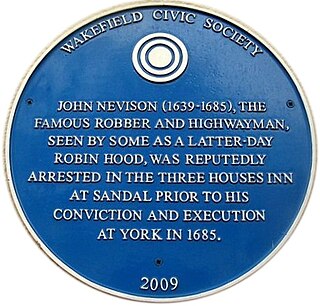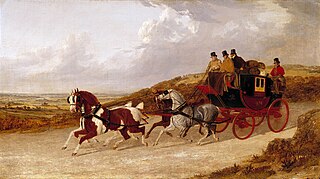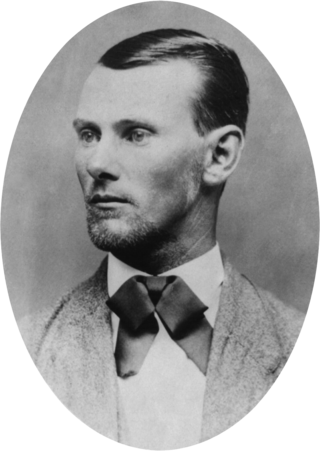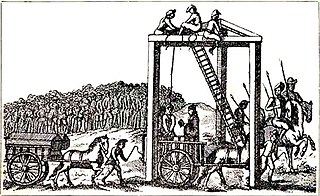
A constellation is an area on the celestial sphere in which a group of visible stars forms a perceived pattern or outline, typically representing an animal, mythological subject, or inanimate object.

Bank robbery is the criminal act of stealing from a bank, specifically while bank employees and customers are subjected to force, violence, or a threat of violence. This refers to robbery of a bank branch or teller, as opposed to other bank-owned property, such as a train, armored car, or (historically) stagecoach. It is a federal crime in the United States.

The Natchez Trace, also known as the Old Natchez Trace, is a historic forest trail within the United States which extends roughly 440 miles (710 km) from Nashville, Tennessee, to Natchez, Mississippi, linking the Cumberland, Tennessee, and Mississippi rivers.

Claude Du Vall (or Duval) (1643 – 21 January 1670) was a French highwayman in Restoration England. He came from a family of decayed nobility, and worked in the service of exiled royalists who returned to England under King Charles II. Little else is known of his history. According to popular legend, he abhorred violence, showing courtesy to his victims and chivalry to their womenfolk, thus spawning the myth of the romantic highwayman, as taken up by many novelists and playwrights.

A highwayman was a robber who stole from travellers. This type of thief usually travelled and robbed by horse as compared to a footpad who travelled and robbed on foot; mounted highwaymen were widely considered to be socially superior to footpads. Such criminals operated until the mid- or late 19th century. Highwaywomen, such as Katherine Ferrers, were said to also exist, often dressing as men, especially in fiction.

John Nevison, also known as William Nevison or Nevinson, was one of Britain's most notorious highwaymen, a gentleman rogue supposedly nicknamed Swift Nick by King Charles II after a renowned 200-mile (320 km) dash from Kent to York to establish an alibi for a robbery he had committed earlier that day. The story inspired William Harrison Ainsworth to include a modified version in his novel Rookwood, in which he attributed the feat to Dick Turpin. There are suggestions that the feat was actually undertaken by Samuel Nicks. The TV series Dick Turpin had an accomplice of the highwayman, Nick, who earned the nickname Swiftnick.

Robber baron is a term of social criticism originally applied to certain wealthy and powerful 19th-century American businessmen. The term appeared as early as the August 1870 issue of The Atlantic Monthly magazine. By the late 19th century, the term was typically applied to businessmen who used exploitative practices to amass their wealth. Those practices included unfettered consumption and destruction of natural resources, influencing high levels of government, wage slavery, squashing competition by acquiring their competitors to create monopolies and/or trusts that control the market, and schemes to sell stock at inflated prices to unsuspecting investors. The term combines the sense of criminal ("robber") and illegitimate aristocracy.

The Highwaymen were an American country music supergroup, composed of four of country music's biggest artists who pioneered the outlaw country subgenre: Johnny Cash, Waylon Jennings, Willie Nelson, and Kris Kristofferson. Between 1985 and 1995, the group recorded three major label albums as The Highwaymen: two on Columbia Records and one for Liberty Records. Their Columbia works produced three chart singles, including the number one "Highwayman" in 1985.
In archaic terminology, a footpad is a robber or thief specialising in pedestrian victims. The term was used widely from the 16th century until the 19th century, but gradually fell out of common use. A footpad was considered a low criminal, as opposed to the mounted highwayman who in certain cases might gain fame as well as notoriety. Footpads operated during the Elizabethan era and until the beginning of the 19th century.

Katherine Ferrers was an English gentlewoman and heiress. According to popular legend, she was also the "Wicked Lady", a highwaywoman who terrorised the English county of Hertfordshire before dying from gunshot wounds sustained during a robbery.
Perumpāṇāṟṟuppaṭai is an ancient Tamil poem in the Pattuppattu anthology of the Sangam literature. It contains 500 lines in the akaval meter. It is one of five arruppatai genre poems and was a guide to other bards seeking a patron for their art. Set as a praise for chieftain Tonataiman Ilantiraiyan of the Kanchi territory, it was composed by Uruttirankannanar sometime around 190–200 CE, states Kamil Zvelebil – a Tamil literature scholar. While the poem is from the 2nd century, it was likely added to the Pattuppāṭṭu anthology in the 4th or 5th century CE, states Dennis Hudson – an Indologist and World Religions scholar. The poem has Several Mentions Of Vishnu and his temples present in Kanchipuram, It also refers Lord Vishnu as the supreme god of the world and Brahma was born from the navel of Maha Vishnu.

A mail coach is a stagecoach that is used to deliver mail. In Great Britain, Ireland, and Australia, they were built to a General Post Office-approved design operated by an independent contractor to carry long-distance mail for the Post Office. Mail was held in a box at the rear where the only Royal Mail employee, an armed guard, stood. Passengers were taken at a premium fare. There was seating for four passengers inside and more outside with the driver. The guard's seat could not be shared. This distribution system began in Britain in 1784. In Ireland the same service began in 1789, and in Australia it began in 1828.
The Highwaymen, also referred to as the Florida Highwaymen, are a group of 26 African American landscape artists in Florida. Two of the original artists, Harold Newton, and Alfred Hair, received training from Alfred “Beanie” Backus. It is believed they may have created a body of work of over 200,000 paintings. They challenged many racial and cultural barriers. Mostly from the Fort Pierce area, they painted landscapes and made a living selling them door-to-door to businesses and individuals throughout Florida from the mid-1950s through the 1980s. They also sold their work from the trunks of their cars along the eastern coastal roads.

Codrington is a rural locality on Portland Bay in the south-west of Victoria, Australia, on the Princes Highway between Portland and Port Fairy. It is a sparsely populated area; at the 2016 census the district had a population of 52 persons, living in 15 dwellings.
Shane Bernagh Donnelly was an Irish rapparee who was active in the Cappagh and Altmore area of County Tyrone during the 17th century who would use the mountains as a vantage point to launch daring hold ups on carriages passing through the area on the main Dublin to Derry road nearby. Local legend has it that the highwayman assisted impoverished locals with his robberies, which primarily targeted members of the Protestant Ascendancy. A barracks was built in the Altmore area in an attempt to curb his activities but to little avail. Because of this Bernagh has over time become a local legend in the mould of Robin Hood who robbed from the rich and gave to the poor.

Jesse Woodson James was an American outlaw, bank and train robber, guerrilla and leader of the James–Younger Gang. Raised in the "Little Dixie" area of Western Missouri, James and his family maintained strong Southern sympathies. He and his brother Frank James joined pro-Confederate guerrillas known as "bushwhackers" operating in Missouri and Kansas during the American Civil War. As followers of William Quantrill and "Bloody Bill" Anderson, they were accused of committing atrocities against Union soldiers and civilian abolitionists, including the Centralia Massacre in 1864.

Steve Venard was a Northern California lawman, and renowned road agent killer. In the course of his career, he killed six highwaymen and made several important captures. He is known for participating in one of the classic gun duels of the Old West, and for being one of the most fearless lawmen of the California Gold Rush era.
The Bold Bank Robbery is a 1904 short crime film produced and distributed by the Lubin Manufacturing Company. The silent film depicts a group of burglars who plan and execute a successful bank heist. Company employee Jack Frawley was the film's director, also coming up with the story and serving as cinematographer; the cast's identities are unknown. The silent film was the first Lubin Manufacturing Company release to feature an original narrative.

Thomas Cox, known as "The Handsome Highwayman", was an English highwayman, sentenced to death and hanged at Tyburn. He had a reputation for a spirited nature and it is reported that when asked if he wished to say a prayer before being hanged, he kicked the ordinary and the hangman out of the cart taking him there.